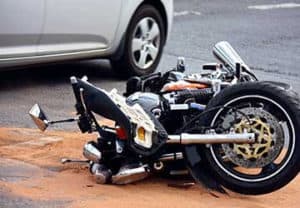Columbia Motorcycle Accident Attorney at Strom Law Firm
If you or a loved one has suffered from a motorcycle accident in Columbia, South Carolina, a Columbia Motorcycle Accident Attorney at the Strom Law Firm is here to offer you the legal guidance and representation you need. A Strom Law Firm’s Columbia Motorcycle Accident Attorney has represented many victims injured in motorcycles, eighteen-wheelers, and other traffic-related car accidents. Motorcycle accidents can lead to severe injuries due to the lack of protection riders have compared to vehicle occupants. We understand motorcyclists’ risks and work diligently to hold negligent parties accountable.
With South Carolina’s frequent warm weather, motorcyclists, not surprisingly, enjoy riding on our state’s roads and highways all year long. While riding motorcycles can be fun and efficient, the activity can also be dangerous. Imagine you are enjoying the South Carolina sunshine on our beautiful roads when a crash occurs and you are lying on the pavement hurt, scared, and alone. Motorcyclists are exposed and vulnerable if they collide with other larger vehicles and are also vulnerable to single-vehicle accidents, especially due to the condition of the SC road or road hazards.
All drivers should understand that they should safely share the road with motorcyclists, but there will always be negligent and dangerous drivers on SC roads. Defective bikes and dangerous roadways or road hazards also pose significant risks to motorcyclists, as do road construction and construction crews. After a crash, an injured motorcyclist should protect their legal rights and discuss the accident with a Columbia motorcycle accident attorney. A lawyer can help you understand if you have a case to receive compensation for your medical bills and other damages.
Common Causes of Motorcycle Accidents in Columbia:
-
Negligent Drivers: Cars making left turns, lane changes, or failing to see motorcyclists.
-
Road Hazards: Potholes, debris, or poor road maintenance pose risks to motorcyclists.
-
Speeding: Both by motorcyclists and other drivers, leading to loss of control or inability to stop in time.
-
Driving Under the Influence: Impaired judgment and reaction times can lead to catastrophic accidents.
Why Choose Strom Law Firm Columbia Motorcycle Accident Attorney for Your Motorcycle Accident Case?
-
Dedicated Representation: We focus on the unique aspects of motorcycle accident cases, understanding the biases motorcyclists face.
-
Thorough Investigation: Gathering crucial evidence from the accident scene, witness statements, and accident reconstruction if necessary.
-
Maximizing Compensation: We work tirelessly to cover all your damages including medical bills, lost wages, pain, suffering, and bike repair or replacement.
-
Experience with Insurance Companies: Navigating the tactics insurance companies use to minimize payouts.
Legal Process for Motorcycle Accident Claims:
-
Consultation: A free initial meeting to discuss details of your accident.
-
Case Building: Collecting evidence and medical records and establishing fault.
-
Negotiation: Engaging with insurance companies for a fair settlement.
-
Litigation: If a settlement isn’t fair, we’re prepared to take your case to court.
Frequently Asked Questions:
Motorcycle Accident Statistics
According to the South Carolina Department of Public Safety, there was one motorcyclist killed every three days in 2019. Of the 1,641 fatal collisions that year, 123 of those involved motorcycles. There were a total of 2,098 motorcycle accidents that occurred in 2019: 424 involved serious injuries and 1,143 involved other types of injuries.
The Helmet Issue
Whether or not to wear a helmet is a highly contentious issue in South Carolina. Before 1980, it was illegal for anyone in South Carolina to ride a motorcycle without wearing a helmet. According to South Carolina’s Code of Laws, Section 56-5-3660, helmets must be worn by operators and passengers under twenty-one.
In 2019, the Department of Public Safety reported that of the 123 fatalities, only 35 of them were wearing helmets. This includes 3 of the 74 that were 20 and younger and 32 of the 742 that were 21 and over.
The State newspaper article from 2019 addresses the two sides of the argument. While many say there are serious injuries and head trauma from minor collisions where a rider is not wearing a helmet, there are others that report neck injuries caused by helmets and can lessen their vision to their surroundings. The truth of the situation is that a helmet is not a magic solution to end or decrease motorcycle deaths and it takes vigilance of all motorists to ensure the safety of motorcycle riders. According to the CDC, helmets reduce the risk of head injury in a motorcycle crash by 69%.
Other Motorcycle Safety Statistics
The National Highway Traffic Safety Administration reports that 32% of all motorcycle riders involved in fatal crashes were speeding, more than drivers of any other vehicle type. In 2017, they report 27% of motorcycle riders involved in fatal crashes did not have valid motorcycle licenses. The Governors Highway Safety Association confirmed motorcycles with anti-lock brakes resulted in 31% less fatal crashes than the same models without.
Columbia Motorcyclists Can Suffer Severe Injuries
There are many types of safety gear designed to protect motorcyclists. However, even a motorcyclist wearing the maximum amount of protective gear is never fully shielded from the possibility of a serious injury if a crash occurs. Even a helmet cannot fully protect from head trauma one hundred percent of the time. Motorcyclists do not have the safety features of a car or truck to protect them, and instead, a car can collide directly with a motorcyclist’s body. While a motorcyclist may be completely under control, it is never possible to control other vehicles or to ensure that vehicles can accurately identify motorcycles on roadways in Columbia.
Even the most protected motorcyclists can be involved in accidents that result in traumatic or fatal injury in SC. The following are examples of injuries commonly resulting from motorcycle accidents:
- Death
- Head fractures
- Traumatic brain injury (TBI)
- Broken bones and shattered bones
- Damage to muscles, tendons, or ligaments
- Neck and back injuries
- Hemorrhaging
- Organ damage
- Spinal cord injury
- Road Rash
It is rare that a motorcyclist will not require some amount of medical care following an accident, and they often need to be transported to a hospital by ambulance. Expenses and medical bills can add up quickly. Fortunately, the law provides a remedy for an injured accident victim to seek compensation from negligent, grossly negligent, or reckless parties.
Common Questions Asked of a Columbia Motorcycle Accident Attorney

A motorcycle ride can quickly shift from a fun adventure into a tragedy. As a motorcyclist, you face dangers ranging from other drivers, defective bikes, weather conditions, and road hazards. If any one of these things causes a crash, you need an experienced lawyer by your side. Protect your legal rights by discussing your case with a Columbia motorcycle attorney as soon as possible.
How common are motorcycle accidents? – Answers from a Columbia Motorcycle Accident Attorney
In South Carolina, one motorcyclist is killed every three days. About 13 percent of fatal motor vehicle accidents, and about 10 percent of accidents resulting in serious injury, involve a motorcycle. Over the last several decades, the number of motorcycle accident fatalities has more than doubled in the state. The amount of serious injuries has increased as well. The rise in accidents corresponds with the growing popularity of motorcycles as a mode of transportation. If you have been in an accident, you can contact a Columbia motorcycle accident lawyer who can help your case.
What safety issues contribute to motorcycle accidents? – Answers from a Columbia Motorcycle Accident Attorney
Various factors contribute to the amount and severity of motorcycle accidents in South Carolina. Most traffic collisions occur on dry roads, during clear weather, and in daylight. While most collisions were not primarily caused by environmental factors, weather, nighttime, and slick roads can contribute to many accidents.
A major safety issue that adds to the severity of an accident is whether or not the motorcyclist was wearing a helmet. In about 68 percent of fatalities, the rider was unhelmeted. In over 61 percent of serious injuries, the rider was not wearing a helmet, and in over half of all other injuries, the rider was unhelmeted.
What special laws apply to motorcycle riders? – Answers from a Columbia Motorcycle Accident Attorney
In South Carolina, certain legal provisions apply specifically to motorcyclists.
- A motorcycle driver can only carry a passenger if their vehicle was designed to carry more than one person.
- Drivers must ensure that they do not operate the motorcycle while carrying anything that prevents them from keeping both hands on the handlebars.
- All motorcycle operators and passengers under 21 must wear a helmet. The Department of Highways and Public Transportation must approve the helmet, and it must come equipped with either a neck or chin strap. It must also have reflectors on both sides of the head.
- Motorcycle operators cannot pass other vehicles using the same lane as the car they’re passing, and they cannot drive between lanes of traffic.
While helmets are not required for motorcyclists over 21 in South Carolina, the CDC estimates that helmets can reduce the risk of head injury in a crash by 69 percent. However, helmet usage does not eliminate the risks of death and serious injury.
What kinds of injuries are usually involved in motorcycle accidents? – Answers from a Columbia Motorcycle Accident Attorney
While motorcycle drivers often wear protective gear, when accidents happen riders are greatly at risk for injury. Unlike car passengers, motorcyclists are more easily injured because they do not have the protection of fully enclosed vehicles. This results in direct contact between vehicles and a motorcyclist’s body, as well as their body and the road.
Common injuries stemming from a motorcycle crash include:
- Road rash and skin scrapes
- Broken and/or shattered bones
- Muscle, tendon, and ligament damage
- Fractures of the head
- Traumatic Brain Injuries (TBIs)
- Damage to organs
- Spinal Cord Injuries (SCIs), which can cause permanent disability
- Neck and back injuries
Even the most minor of accidents usually necessitate medical care. Most victims require being taken to the hospital. This results in bills for ambulance rides, diagnostics, and treatment of injuries. Contact a qualified motorcycle accident attorney after your accident so that you can promptly seek compensation for your injuries.
What compensation do I deserve after a motorcycle accident? – Answers from a Columbia Motorcycle Accident Attorney
Damages in a motorcycle accident personal injury case can include:
- Medical expenses: injuries resulting from a motorcycle accident can require long-term, and even lifelong, care. If your accident caused an SCI, a TBI, permanent disability, or triggered chronic pain, your medical bills will quickly become astronomical. Costs can include hospital stays, diagnostics, tests, specialists, surgeries, skilled long-term nursing, rehabilitation, medicine, medical equipment, physical therapy, and regular doctors’ visits.
- Lost wages and reduced earning potential: motorcycle accident injuries are often severe enough to force you to take time off work, either temporarily or permanently. A motorcycle accident can result in a long, or even permanent, period of recovery. Time not spent at work means no earnings. Moreover, the extent of your injuries can limit your ability to work. Some victims will never be able to return to work again. Lost wages and reduced earning potential can be a massive part of the damages claimed in any motorcycle injury case.
Your family members can also sustain financial losses from lost wages because they must take time off to help in your recovery.
- Pain and Suffering: You can recover damages for psychological pain associated with your physical injuries, such as depression, anxiety, PTSD, or other mental health issues that result from your accident. You can also recover damages for lost quality or enjoyment of life.
Again, your family members may file claims for pain and suffering to get compensation. They have suffered a decreased quality of life, lost emotional support, companionship, and consortium with you.
Our Columbia Motorcycle Accident Attorney can ensure that you recover compensation for:
- Ambulance costs
- Emergency room treatment
- Hospital expenses for your initial stay, including any surgical and diagnostic costs
- Ongoing medical expenses associated with the injury, including any follow-up hospitalizations
- Rehabilitative care as you initially recover from the injury
- Long-term care and skilled nursing that you need in your day-to-day life
- Anticipated future care based on the extent of your injury
- Lost earnings and diminished future earning potential for you and your loved ones
- Pain, suffering and emotional distress for you and your loved ones
- Permanent impairment
- Reduction in quality of life
- Wrongful death damages for your loved ones
Who is liable for your Motorcycle Accident? – Answers from a Columbia Motorcycle Accident Attorney
Most motorcycle accidents involve another driver being negligent. In any motor vehicle accident case, you have a lower burden of proof for damages than in other personal injury cases. When someone drives a vehicle, they owe you a duty of care and are responsible for following traffic and safety laws. Furthermore, it can be much easier to establish that your injuries were the result of the motorcycle accident rather than some other contributory factor.
Even with a lower burden, you must still be able to establish that the driver was at fault for the accident.
Our Columbia motorcycle accident lawyers can establish this evidence with:
- Witness statements
- Photographs of the scene of the accident
- Police reports and whether the other driver was issued a ticket
- Accident reconstruction expert reports
- Weather reports
- Phone records (to establish that the driver was using their phone or texting)
Other potential parties at fault include the government agency in charge of maintaining the public roads and highways and ensuring they are properly lit, and the manufacturer of your motorcycle if it was built with defects or defective parts. A practiced motorcycle injury attorney can help you determine which party or parties are responsible for your injuries. The process of litigating your case may be incredibly complex—especially if multiple parties are involved. Your lawyer will help parse all the legal issues raised by your case and develop the best strategy possible.
Why do I need a Columbia Motorcycle Accident Attorney to help me with my motorcycle accident injury case, and how can I afford one?
A compassionate and experienced Columbia Motorcycle Accident Attorney will help you with the process of establishing which parties broke their duty of care to you and proving your damages.
A Columbia Motorcycle Accident Attorney will help you:
- Investigate the accident fully. This will include gathering evidence from the scene and reconstructing the site. This can include video surveillance footage when available, statements from witnesses, and physical evidence from the scene
- Gathering and preserving any evidence discovered
- Investigating what insurance coverage is available
- Proving the full extent of your injuries using your medical records and expert testimony
- Calculating all of your losses, including future losses (such as lost earning potential and pain and suffering)
- Negotiating with the insurance companies to maximize your settlement
After an accident, you are already dealing with a mountain of expenses and stress. An attorney shouldn’t add to your financial stress. A Columbia Motorcycle Accident Attorney at the Strom Law Firm offers free consultations on your case, and they work on a contingency basis. That means you do not have to pay a dime until your case is settled and you receive the compensation you deserve. Your lawyers will be paid their costs and fee of 33.3 percent of your settlement, or if your case goes to trial, they will be paid their costs and trial fee of 40 percent of your award.
Can you be held responsible for your accident?
South Carolina is known as a modified comparative negligence state. Under the South Carolina Code of Laws Section 15-38-15, your total award is reduced proportionally by your percentage of fault. If you are in an accident resulting in damages, an experienced motorcycle accident attorney can minimize any comparative negligence arguments to ensure that you maximize your overall recovery.
Should you talk to the insurance adjuster and accept the insurance company’s settlement before talking to a Columbia Motorcycle Accident Attorney?
Never talk to the insurance company without a Columbia Motorcycle Accident Attorney. Your Columbia Motorcycle Accident Attorney will handle all communication with the insurance adjuster, starting at the very beginning of the claim. You want to avoid saying anything the adjusters can use against you, as they actively work to prevent you from receiving the compensation you are entitled to. Most insurance companies want to settle out of court, and your motorcycle accident attorney will ensure that your final settlement amount is the full amount your injuries warrant.

Several factors will influence your settlement amount. Your lawyer will be diligent in using the facts of your case to make sure your offer includes all of your eligible expenses.
The factors involved in your accident case could include:
- How severe your injuries are
- The extent of your medical costs and expenses
- The likelihood that you will have future and/or long-term medical expenses
- You and your family’s pain and suffering, PTSD, anxiety, depression, and any damages related to scarring or disfigurement.
How can a Columbia motorcycle accident attorney assist you?
A motorcycle accident can cause massive physical, mental, and emotional burdens on both you and your family. Work with a compassionate Columbia motorcycle accident attorney to give you peace of mind. We are eexperenced in accident litigation, and we will devise a strategy for your case, investigate and gather evidence, and work with experts to document and establish the full extent of your damages. Remember, our accident lawyers offer a free case evaluation, and we do not collect a penny until we recover compensation for you. If you have been injured in a motorcycle crash in Columbia or elsewhere in South Carolina, contact a Columbia Motorcycle Accident Attorney to schedule your free consultation. Call our team of Columbia motorcycle accident attorney now to learn more about how we can help represent you and get you the settlement you deserve.
Motorcycle Safety Tips
Motorcycles are a popular form of transportation, and many bikers are on the road today. If you or a loved one ride a motorcycle, please consider a few safety tips:
-
- Always wear a full-face helmet and safe riding gear.
- Make sure your motorcycle is road-ready before you ride – check tires, lights, fluids, and brakes.
- Avoid wet or slick roads when possible.
- Never drink alcohol and drive – more than ¼ of fatal motorcycle crashes involve alcohol. Please remain sober while you ride.
Learn How a Columbia Motorcycle Accident Attorney Can Assist You
If you’re a motorcyclist in Columbia, SC, dealing with the aftermath of an accident, let Strom Law Firm be your advocate. Our commitment is to fight for the justice and compensation you deserve, allowing you to focus on recovery. Motorcycle accidents can leave devastating injuries in their wake, causing untold emotional, financial, and personal devastation to families and individuals. If you have been injured in a motorcycle crash in Columbia, Richland County, or anywhere else across South Carolina, contact us. Our Columbia Motorcycle Accident Attorney offers free case evaluations, and we do not collect a fee unless we recover for you. Call 803-252-4800 to speak with a Columbia motorcycle accident attorney today, or contact us online and find out if we can help you.
Client Review
Here’s what Alma P. said about us on Google:
“Great law firm…awesome costumer service! Absolute pleasure to work with! I Would recommend this law firm to anyone.”
Rating: 5/5 ⭐⭐⭐⭐⭐
Check out all of our Google reviews!


















